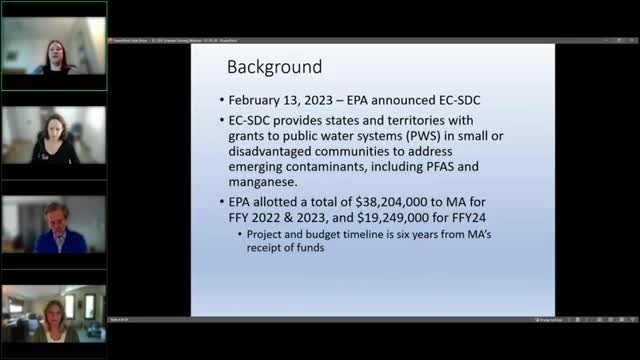Massachusetts secures $57 million in federal grants for public water systems to combat contaminants
January 03, 2025 | Massachusetts Department of Environmental Protection, Executive , Massachusetts
This article was created by AI summarizing key points discussed. AI makes mistakes, so for full details and context, please refer to the video of the full meeting. Please report any errors so we can fix them. Report an error »

In a recent training webinar hosted by the Massachusetts Department of Environmental Protection (MassDEP), public water systems from small and disadvantaged communities gathered to discuss the crucial EC-SDC grant program. This initiative aims to tackle emerging contaminants in drinking water, including PFAS and manganese, which have raised significant health concerns across the nation.
The meeting highlighted the substantial federal funding allocated to Massachusetts, with a total of $38.2 million designated for the fiscal years 2022 and 2023, and an additional $19.2 million for fiscal year 2024. This funding is set to support projects over a six-year timeline, extending through September 2029 for the earlier funds and 2030 for the latter. Such long-term financial backing is essential for communities striving to enhance their water quality and safety.
Participants were guided through the grant process, which is currently at the award letter stage for many grantees. MassDEP officials explained the steps involved, from reviewing contracts to issuing notices to proceed, which allow grantees to submit invoices for reimbursement. This structured approach ensures that public water systems can efficiently manage their projects and funding.
A key focus of the webinar was the introduction of a new project specifications document. This concise overview will streamline communication and provide essential details about each project, ensuring that all parties are aligned on objectives and expectations. Additionally, an invoicing template was presented, designed to simplify the reimbursement process for grantees. This template will help ensure that all necessary information is included with each invoice, facilitating timely payments and project continuity.
As the meeting concluded, participants were encouraged to stay vigilant for further communications from MassDEP regarding these new tools and processes. The proactive measures discussed during the webinar reflect a commitment to improving drinking water quality in Massachusetts, particularly for those communities that need it most. With the support of federal funding and clear guidance from state officials, these public water systems are poised to make significant strides in safeguarding public health.
The meeting highlighted the substantial federal funding allocated to Massachusetts, with a total of $38.2 million designated for the fiscal years 2022 and 2023, and an additional $19.2 million for fiscal year 2024. This funding is set to support projects over a six-year timeline, extending through September 2029 for the earlier funds and 2030 for the latter. Such long-term financial backing is essential for communities striving to enhance their water quality and safety.
Participants were guided through the grant process, which is currently at the award letter stage for many grantees. MassDEP officials explained the steps involved, from reviewing contracts to issuing notices to proceed, which allow grantees to submit invoices for reimbursement. This structured approach ensures that public water systems can efficiently manage their projects and funding.
A key focus of the webinar was the introduction of a new project specifications document. This concise overview will streamline communication and provide essential details about each project, ensuring that all parties are aligned on objectives and expectations. Additionally, an invoicing template was presented, designed to simplify the reimbursement process for grantees. This template will help ensure that all necessary information is included with each invoice, facilitating timely payments and project continuity.
As the meeting concluded, participants were encouraged to stay vigilant for further communications from MassDEP regarding these new tools and processes. The proactive measures discussed during the webinar reflect a commitment to improving drinking water quality in Massachusetts, particularly for those communities that need it most. With the support of federal funding and clear guidance from state officials, these public water systems are poised to make significant strides in safeguarding public health.
View full meeting
This article is based on a recent meeting—watch the full video and explore the complete transcript for deeper insights into the discussion.
View full meeting
